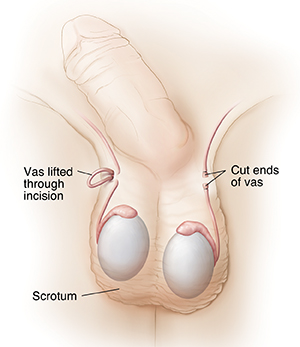Having a Vasectomy: Before, During, and After the Procedure
Vasectomy is an outpatient procedure. This means you can go home the same day. It can be done in a healthcare provider’s office, clinic, or hospital. Your provider will talk with you about how to get ready for surgery. They'll also talk about the possible risks and complications with you. After the procedure, follow your provider’s advice for recovery.
Getting ready for surgery
Your provider will talk with you about how to get ready for surgery. You should:
-
Sign a consent form. This must be done at least a few days before surgery. It gives your provider permission to do the procedure. It also states that a vasectomy isn't guaranteed to make you unable to produce children (sterile).
-
Ask your healthcare provider if you need to stop taking any medicines before the procedure.
-
Tell your provider if you’ve had any scrotal surgery in the past.
-
Arrange for an adult family member or friend to give you a ride home after surgery.
-
Shower and clean your scrotum the day of surgery. Your provider may also ask you to shave your scrotum.
-
Bring a jock strap (athletic supporter) or pair of snug cotton briefs to the provider’s office or hospital.
-
Follow all directions you are given for not eating or drinking before surgery.
During surgery
 |
| The cut ends of the vas may be tied, closed with a clip, or sealed by heat (cauterized). |
The procedure often lasts less than 30 minutes.
-
You’ll be asked to undress and lie on a table.
-
You may be given medicine to help you relax. To prevent pain during surgery, you’ll be given a shot (injection) of pain medicine in your scrotum or lower groin.
-
Once the area is numb, the provider will make 1 or 2 small cuts (incisions) in the scrotum. This may be done with a scalpel or with a pointed clamp (no-scalpel method).
-
The vas deferens are lifted through the incision and cut. The provider then seals off the ends of the vas deferens.
-
If needed, the incision is closed with stitches or skin glue.
-
You can rest for a while until you’re ready to go home.
Recovering at home
For about 1 week, your scrotum may look bruised and slightly swollen. You may also have a small amount of bloody discharge from the incision. This is normal.
To help make your recovery more comfortable:
-
Stay off your feet as much as possible for the first 2 days.
-
Wear an athletic supporter or snug cotton briefs for support.
-
Reduce swelling by using an ice pack. To make an ice pack, put ice cubes in a plastic bag that seals at the top. Wrap the bag in a clean, thin towel or cloth. Never put ice or an ice pack directly on the skin.
-
Take medicine, such as acetaminophen, to ease any mild pain. Don’t use aspirin.
-
Wait 48 hours before bathing.
-
Don't do any heavy lifting or exercise for 7 days.
-
Ask your provider how long to wait before having sex again. Remember: You must use another form of birth control until you’re completely sterile.
When to get medical care
Call your provider if you have any of these after surgery:
-
More pain or swelling in your scrotum
-
A large black-and-blue area or a growing lump
-
Fever
-
Chills
-
More redness or fluid leaking at the incision
-
Trouble peeing
Sex after vasectomy
Vasectomy doesn’t change your sexual function. So when you start having sex again, it should feel the same as before. A vasectomy also shouldn’t affect your relationship with your partner. But it’s important to remember that you won’t become sterile right away. It takes time before you can have sex without the need for birth control.
-
Until you’re sterile: After a vasectomy, some active sperm still remain in your semen. It will take time and many ejaculations before the sperm are completely gone. During this time, you must use another birth control method to prevent pregnancy. To make sure no sperm are left in your semen, you’ll need to have 1 or more semen exams about 6 to 8 weeks after your procedure. You usually collect a semen sample at home and bring it to a lab. The sample is then checked under a microscope. You’re sterile only when these samples show no evidence of sperm. Ask your provider if more follow-up is needed.
-
After you’re sterile: After your provider says you are sterile, you no longer need to use any form of birth control. You are free to have sex without the fear of unwanted pregnancy. But a vasectomy doesn't protect you from sexually transmitted infections (STIs). If you have more than 1 sex partner, practice safer sex by using condoms.
Online Medical Reviewer:
L Renee Watson MSN RN
Online Medical Reviewer:
Marc Greenstein MD
Online Medical Reviewer:
Melinda Murray Ratini DO
Date Last Reviewed:
4/1/2024
© 2000-2025 The StayWell Company, LLC. All rights reserved. This information is not intended as a substitute for professional medical care. Always follow your healthcare professional's instructions.